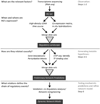Regeneration in the era of functional genomics and gene network analysis
- PMID: 21876108
- PMCID: PMC4109899
- DOI: 10.1086/BBLv221n1p18
Regeneration in the era of functional genomics and gene network analysis
Abstract
What gives an organism the ability to regrow tissues and to recover function where another organism fails is the central problem of regenerative biology. The challenge is to describe the mechanisms of regeneration at the molecular level, delivering detailed insights into the many components that are cross-regulated. In other words, a broad, yet deep dissection of the system-wide network of molecular interactions is needed. Functional genomics has been used to elucidate gene regulatory networks (GRNs) in developing tissues, which, like regeneration, are complex systems. Therefore, we reason that the GRN approach, aided by next generation technologies, can also be applied to study the molecular mechanisms underlying the complex functions of regeneration. We ask what characteristics a model system must have to support a GRN analysis. Our discussion focuses on regeneration in the central nervous system, where loss of function has particularly devastating consequences for an organism. We examine a cohort of cells conserved across all vertebrates, the reticulospinal (RS) neurons, which lend themselves well to experimental manipulations. In the lamprey, a jawless vertebrate, there are giant RS neurons whose large size and ability to regenerate make them particularly suited for a GRN analysis. Adding to their value, a distinct subset of lamprey RS neurons reproducibly fail to regenerate, presenting an opportunity for side-by-side comparison of gene networks that promote or inhibit regeneration. Thus, determining the GRN for regeneration in RS neurons will provide a mechanistic understanding of the fundamental cues that lead to success or failure to regenerate.
Figures



Similar articles
-
Preferential regeneration of spinal axons through the scar in hemisected lamprey spinal cord.J Comp Neurol. 1991 Nov 22;313(4):669-79. doi: 10.1002/cne.903130410. J Comp Neurol. 1991. PMID: 1783686
-
Regenerative capacity in the lamprey spinal cord is not altered after a repeated transection.PLoS One. 2019 Jan 30;14(1):e0204193. doi: 10.1371/journal.pone.0204193. eCollection 2019. PLoS One. 2019. PMID: 30699109 Free PMC article.
-
Lampreys and spinal cord regeneration: "a very special claim on the interest of zoologists," 1830s-present.Front Cell Dev Biol. 2023 May 9;11:1113961. doi: 10.3389/fcell.2023.1113961. eCollection 2023. Front Cell Dev Biol. 2023. PMID: 37228651 Free PMC article.
-
Contributions of identifiable neurons and neuron classes to lamprey vertebrate neurobiology.Prog Neurobiol. 2001 Mar;63(4):441-66. doi: 10.1016/s0301-0082(00)00050-2. Prog Neurobiol. 2001. PMID: 11163686 Review.
-
Molecular mechanisms of spinal cord injury repair across vertebrates: A comparative review.Eur J Neurosci. 2024 Aug;60(4):4552-4568. doi: 10.1111/ejn.16462. Epub 2024 Jul 8. Eur J Neurosci. 2024. PMID: 38978308 Review.
Cited by
-
Decreased Adiponectin Levels Are a Risk Factor for Cognitive Decline in Spinal Cord Injury.Dis Markers. 2022 Jan 17;2022:5389162. doi: 10.1155/2022/5389162. eCollection 2022. Dis Markers. 2022. PMID: 35082930 Free PMC article.
-
Structural and Molecular Mechanisms of Cytokine-Mediated Endocrine Resistance in Human Breast Cancer Cells.Mol Cell. 2017 Mar 16;65(6):1122-1135.e5. doi: 10.1016/j.molcel.2017.02.008. Mol Cell. 2017. PMID: 28306507 Free PMC article.
-
Non-mammalian model systems for studying neuro-immune interactions after spinal cord injury.Exp Neurol. 2014 Aug;258:130-40. doi: 10.1016/j.expneurol.2013.12.023. Exp Neurol. 2014. PMID: 25017894 Free PMC article. Review.
-
The Lesioned Spinal Cord Is a "New" Spinal Cord: Evidence from Functional Changes after Spinal Injury in Lamprey.Front Neural Circuits. 2017 Nov 6;11:84. doi: 10.3389/fncir.2017.00084. eCollection 2017. Front Neural Circuits. 2017. PMID: 29163065 Free PMC article. Review.
-
CRISPR/Cas9-mediated mutagenesis in the sea lamprey Petromyzon marinus: a powerful tool for understanding ancestral gene functions in vertebrates.Development. 2015 Dec 1;142(23):4180-7. doi: 10.1242/dev.125609. Epub 2015 Oct 28. Development. 2015. PMID: 26511928 Free PMC article.
References
-
- Armstrong J, Zhang L, McClellan AD. Axonal regeneration of descending and ascending spinal projection neurons in spinal cord-transected larval lamprey. Exp. Neurol. 2003;180:156–166. - PubMed
-
- Ayers J, Carpenter GA, Currie S, Kinch J. Which behavior does the lamprey central motor program mediate? Science. 1983;221:1312–1314. - PubMed
-
- Bajoghli B, Aghaallaei N, Hess I, Rode I, Netuschil N, Tay BH, Venkatesh B, Yu JK, Kaltenbach SL, Holland ND, et al. Evolution of genetic networks underlying the emergence of thymopoiesis in vertebrates. Cell. 2009;138:186–197. - PubMed
-
- Basch ML, Bronner-Fraser M, Garcia-Castro MI. Specification of the neural crest occurs during gastrulation and requires Pax7. Nature. 2006;441:218–222. - PubMed
-
- Beattie MS, Bresnahan JC, Lopate G. Metamorphosis alters the response to spinal cord transection in Xenopus laevis frogs. J. Neurobiol. 1990;21:1108–1122. - PubMed
Publication types
MeSH terms
Grants and funding
LinkOut - more resources
Full Text Sources
Miscellaneous

